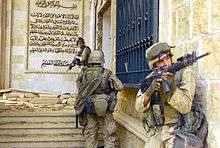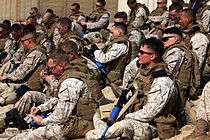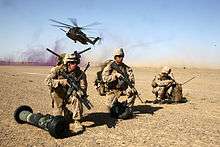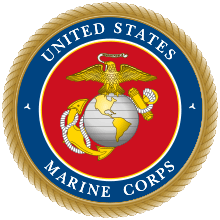1st Battalion, 7th Marines
The 1st Battalion, 7th Marines (1/7) is an infantry battalion of the United States Marine Corps. It is based at the Marine Corps Air Ground Combat Center Twentynine Palms, consists of approximately 1,000 Marines, and is part of the 1st Marine Division.
Famous Marines who have served in 1/7 include General Raymond G. Davis, General James Mattis, Lieutenant General Lewis "Chesty" Puller, and Gunnery Sergeant John Basilone.
Subordinate units
- Headquarters and Service Company
- Animal Company
- Baker Company
- Suicide Charley Company
- Weapons Company
History
The 1st Battalion, 7th Marines was created on 1 April 1921 in San Diego, California. In September 1924, the Battalion was deactivated with its personnel being absorbed by the newly organized 4th Marine Regiment. For the next twenty years the Battalion was activated, re-designated and disbanded on numerous occasions until being reborn on 1 January 1941.
World War II
Just over a year after its rebirth, the Battalion deployed to take part in the Pacific Theater during World War II, where its personnel saw their first action of the war at Guadalcanal. Under its commander, Lieutenant Colonel Lewis B. "Chesty" Puller, the Battalion distinguished itself many times over for valor and bravery as it valiantly held its positions against the onslaught of a regiment of seasoned Japanese attackers. It was also during this campaign that the legendary Sgt "Manila John" Basilone was awarded the Medal of Honor for defending the regiment from a comprehensive Japanese assault using only a machine gun. Throughout the remainder of the war, the "First Team" distinguished itself throughout many campaigns, including the Battle of Cape Gloucester, the Battle of Peleliu and the Battle of Okinawa.
The battalion deployed to North China for occupation duty at the end of the war.
Korean War
Following World War II, the "First of the Seventh" was sent to Camp Pendleton in California where it was deactivated on 5 March 1947. However, in response to the invasion of South Korea by the communist North Korea, the battalion was again called into action. On 21 September 1950, the unit carried out an amphibious landing at Inchon. Once more the "First Team" distinguished itself in battle fighting its way to and from the Chosin Reservoir and in the First Battle of the Hook. It was during this war that such names as 1st Lt Frank Mitchell, SSgt Archie Van Winkle and Lt Col Raymond C. Davis, became part of Marine Corps history when each were awarded the Medal of Honor. (Another Marine that received the MOH during the Hook was 2nd Lt. George H. O'Brien, Jr. of Texas) {{Citation needed}}
Following the cessation of hostilities in Korea and through 1965, the Battalion spent time both in Camp Pendleton and Okinawa while maintaining its combat readiness.
Vietnam War
In August 1965, the battalion was once again called to service, this time in the Republic of Vietnam. 1/7 Battalion commander, Lt. Colonel James P. Kelly led the "First Team" in 1965-1966 as they participated in numerous operations such as 'Starlite', Piranha', 'Mameluke Thrust' and 'Oklahoma Hills'. During these operations and many others, the battalion was honored repeatedly, earning the Presidential Unit Citation Streamer four times and the Meritorious Unit Commendation Streamer three times; while Robert R. Ingram would be awarded the Medal of Honor in 1966 (part of Lt. Col. Kelly's battalion).[1] Corporal Larry Eugene Smedley of Delta Company, 1/7 was awarded the Medal of Honor posthumously for action that took place on Dec. 20, 1967. Private First Class Ralph Dias of Delta Company, 1/7 was awarded the Medal of Honor posthumously for action that took place in November 1969.
Five Marines from the battalion were responsible for the only war crime brought to charge against the Marine Corps during the Vietnam War. On 19 February 1970, in the Son Thang massacre just southwest of Danang, a five-man patrol from the unit executed five women and eleven children. One member of the team was convicted of premeditated murder but had served less than a year in prison[2]
Gulf War
The 1st Battalion, 7th Marines was the first unit to man defensive positions in Saudi Arabia during Operation Desert Shield in August 1990. The unit was an integral member of Task Force Ripper. As Desert Shield became Desert Storm, the battalion participated in the diagonal thrust to the perimeter of Kuwait City, spearheading the liberation of Kuwait from Iraq. The battalion returned to Twentynine Palms in March 1991.
Somalia
On 11 December 1992, the first elements of 1st Battalion, 7th Marines arrived at Mogadishu, Somalia for Operation Restore Hope. Battalion operations were conducted in Baidoa, Bardera, Oddur, Afgoye and Mogadishu. The battalion relieved Task Force Mogadishu for occupation of the Stadium Complex in Mogadishu on 25 January 1993. The following night, Lance Corporal Anthony Botello was killed by a sniper while on night patrol in the city.[3] He was the only other marine other than Pfc. Domingo Arroyo of 3/11 to be killed in action in Somalia. The Battalion turned over their mission and area of operations in Mogadishu to the 10th Baluch Battalion on 24 April 1993 and returned to Twentynine Palms.
Operation Iraqi Freedom

In January 2003, the Battalion was deployed on Operation Iraqi Freedom. It crossed the Kuwaiti border into Iraq on 18 March; its first mission was to seize the strategically prominent oil pumping and control station in Az Zubayr. This station was so important because more than 50% of Iraq's oil was controlled by it.[4] The Battalion saw significant combat action on its way to Baghdad and in the streets of the Iraqi capital. On 23 April, the Battalion turned over control of their sector to the U.S. Army and took up positions in the city of An Najaf. After countless extensions, the Battalion returned to Twentynine Palms, on 5 October 2003.
In August 2004, the Battalion deployed once more, but this time to Western Iraq in support of Operation Iraqi Freedom II. There the Battalion conducted security operations in the cities and roadways along the Euphrates River and Syrian border to include Husaybah, Karabilah, Sadah, Ubaydi, Al Qa'im, Haditha, Hit and Haqlania. Involved in combat operations on a daily basis, battalion personnel conducted mounted and dismounted urban patrols, cordon knocks, Main Supply Route (MSR) security, sweep operations, and border security to clear the Battalions' Area of Operation (AO) of enemy insurgents.

In March 2006, the Battalion again deployed to Iraq and operated near the Iraqi-Syrian border, conducting dismounted urban patrols, weapons cache sweeping and vehicle checkpoints.[5] It returned in September 2006.[6]
1/7 returned to Western Al Anbar in August 2007. Assigned to AO Hīt, the Marines conducted thousands of combat patrols and weapon cache sweeps. The Task Force found over 22,000 pieces of ordnance during the deployment and captured over 200 suspected terrorists and criminals. TF 1/7 was partnered with two Iraqi infantry battalions and two police districts. The training and development of the Iraqi units was so successful that the city of Hit was the first city within the Al Anbar Province to be returned to Iraqi control. The Battalion returned to 29 Palms in March 2008.
In February 2009, 1/7 returned to the Al Anbar province. Assigned to Fallujah and Al-Karmah, it was tasked to maintain security in the area with close cooperation with Iraqi police, the Iraqi Army and Provincial Security Forces. Upon departing the region in August and September 2009, the battalion turned over the AO to Iraqi control before returning to the United States.
Operation Enduring Freedom
In March 2012, 1/7 deployed to Sangin District, Helmand Province, Afghanistan to conduct counterinsurgency operations and support the transition of authority from U.S. forces to the Afghan National Security Forces. The battalion returned in October 2012.

In March 2014, 1/7 again deployed to Helmand Province, Afghanistan. The battalion retrograded from Sangin district on 5 May 2014, and turned over security responsibility of the area to the Afghan National Army. The infantrymen of 1/7 were the final Marines to occupy FOB Sabit Qadam and the surrounding area in Sangin District.[7] During the battalion’s approximately seven-month-long deployment, the "First Team" was responsible for a number of successful missions throughout Helmand province.
"They should be proud of what they contributed to the campaign," said Brig. Gen. Daniel Yoo. "They have been involved in everything from the northern Helmand retrograde from Sangin, which was historic for the Marine Corps but also for 1st Battalion, 7th Marines, because of their previous deployment there. They were involved in the central Helmand liftoff to support our U.K. brothers as they picked up and moved out of Lashkar Gah. They were involved in elections prep from both the primary elections and the runoff elections." Unfortunately, amidst the battalion’s success came two devastating incidents. The first incident occurred while providing security, 25 June, when Sgt. Thomas Spitzer, a Scout Sniper assigned to the Scout Sniper Platoon, was killed in action. The second occurred during a dismounted combat patrol, 9 Aug., when Staff Sgt. Brandon Dodson, a platoon sergeant with Baker Co., stepped on an improvised explosive device. Dodson was severely injured, but he maintains a positive attitude and is committed toward his recovery at Walter Reed National Military Medical Center. On 1 October 2014, 1/7 transferred their area of responsibility to 3rd Squadron, 3rd Cavalry Regiment, a U.S. Army command based out of Fort Hood, Texas.[8]

Medal of Honor recipients

- World War II
- GySgt John Basilone, 24–25 October 1942, Guadalcanal
- Korean War
- SSgt Archie Van Winkle, 2 November 1950, Korea
- Sgt James I. Poynter, 4 November 1950, Korea (Posthumous)
- 1st Lt Frank N. Mitchell, 26 November 1950, Korea (Posthumous)
- Lt Col Raymond G. Davis, 1–4 December 1950, Korea
- PFC Herbert A. Littleton, 22 April 1951, Korea (Posthumous)
- Sgt Frederick W. Mausert, III, 12 September 1951, Korea (Posthumous)
- Cpl David B. Champagne, 28 May 1952, Korea (Posthumous)
- PFC John D. Kelly, 28 May 1952, Korea (Posthumous)
- Vietnam War
- HM3 Robert R. Ingram, 28 March 1966, Vietnam
- Cpl Larry E. Smedley, 20–21 December 1967, Vietnam (Posthumous)
- PFC Ralph E. Dias, 12 November 1969, Vietnam (Posthumous)
Notable former members
- William Atwater during the Vietnam War
- Chesty Puller on Guadalcanal during World War II
- Bing West, with CAP Lima-One during the Vietnam War
- James Mattis, Battalion Commander, Desert Storm
- Dale Shewalter, during the Vietnam War
See also
| Wikimedia Commons has media related to 1st Battalion 7th Marines. |
Notes
- SuicideCharley.Com (2 July 2008). "Suicide Charley Medal Of Honor Recipients". SuicideCharley.Com News. Archived from the original on 2 December 2009. Retrieved 1 January 2010.
- Warren, "American Spartans", p. 350
- "LCPL Anthony "Tony" David Botello". battleofmogadishu.com. Archived from the original on 21 August 2014.
- Gordon (2006), p.220-21.
- Corporal Antonio Rosas (2 July 2006). "Marines battle the elements while facing insurgents and improvised explosive devices". Marine Corps News. Archived from the original on 4 July 2006. Retrieved 3 July 2006.
- "1/7 Marines return from third deployment to warm welcome". OP-29-Online. 6 October 2006. Retrieved 7 October 2006.
- http://www.marines.mil/Photos.aspx?igphoto=2000795558
- Jackson, Staff Sgt. John (2 October 2014). "1/7 transfers authority, ends operations in Helmand province, Afghanistan". I Marine Expeditionary Force. Archived from the original on 18 October 2014.
References
![]()
- Bibliography
- Gordon, Michael R.; General Bernard E. Trainor (2006). Cobra II: The Inside Story of the Invasion and Occupation of Iraq. New York: Random House. ISBN 1-4000-7539-4.
- Owen, Joseph R. (1997). Colder Than Hell: A Marine Rifle Company at Chosin Reservoir. Ballantine Books. ISBN 0-8041-1697-0.
- Solis, Gary D. (1997). Son Thang: An American War Crime. United States Naval Institute Press. ISBN 1-55750-743-0.
- Warren, James A. (2007). American Spartans: The U.S. Marines: A Combat History from Iwo Jima to Iraq. Pocket Books. ISBN 978-1-4165-3297-2.
- Web
- "Official Website of 1/7". United States Marine Corps. Archived from the original on 6 December 2008. Retrieved 9 September 2008.
- "1st Battalion 7th Marines History". First Battalion Seventh Marines-Korea 1950-1953. Archived from the original on 27 April 2006. Retrieved 7 June 2006.
- "1st Battalion 7th Marines History Via Suicide Charley.Com". First Battalion Seventh Marines History. Archived from the original on 5 February 2010. Retrieved 1 January 2010.


